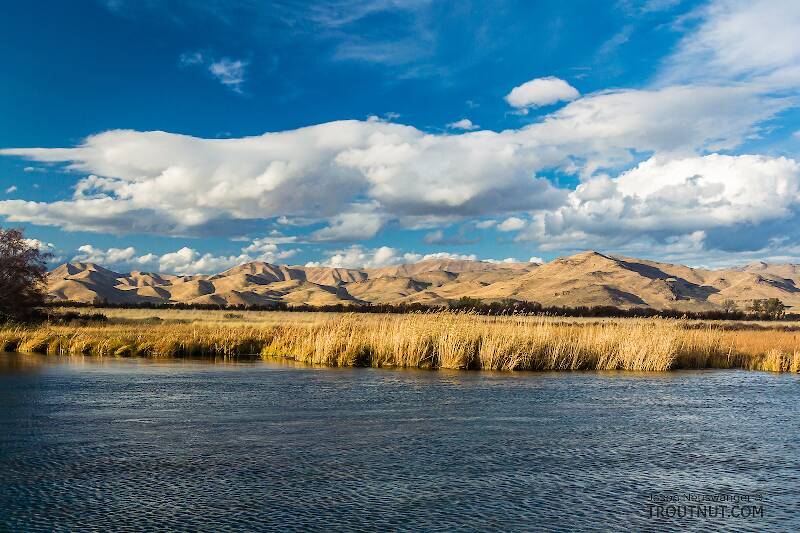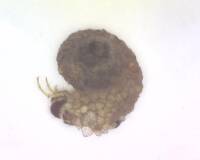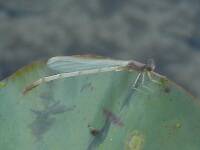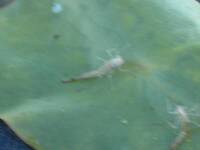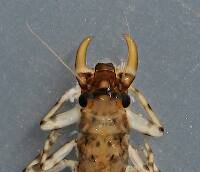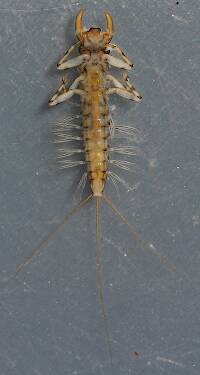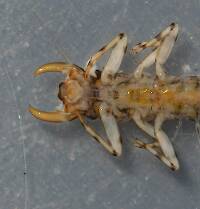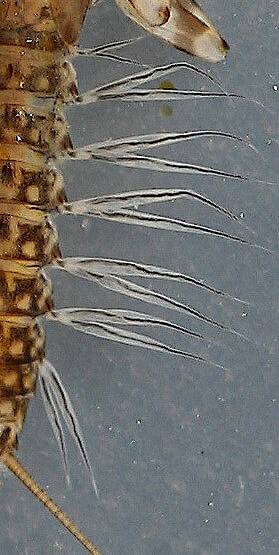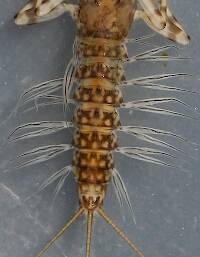
Blue-winged Olives
Baetis
Tiny Baetis mayflies are perhaps the most commonly encountered and imitated by anglers on all American trout streams due to their great abundance, widespread distribution, and trout-friendly emergence habits.
Featured on the forum

With a bit of help from the microscope, this specimen keys clearly and unsurprisingly to Hydropsyche.

Troutnut is a project started in 2003 by salmonid ecologist Jason "Troutnut" Neuswanger to help anglers and
fly tyers unabashedly embrace the entomological side of the sport. Learn more about Troutnut or
support the project for an enhanced experience here.
Promethean
Posts: 2
Posts: 2
Promethean on Oct 3, 2006October 3rd, 2006, 9:00 pm EDT
Hi all,
Im interested in starting a bit of a collection of aquatic insects in my local area. I have heard that a good way to do this for the adult specimens was to pin them out on a bit of card. Does anyone know of any resources that describe pinning techniques or can give me any other information on further preservation? I dont really want hundreds of small bottles with preserving liquid around the house, but is there a way to treat the specimens before they dry to stop them disintergrating?
Thanks
Joel
Im interested in starting a bit of a collection of aquatic insects in my local area. I have heard that a good way to do this for the adult specimens was to pin them out on a bit of card. Does anyone know of any resources that describe pinning techniques or can give me any other information on further preservation? I dont really want hundreds of small bottles with preserving liquid around the house, but is there a way to treat the specimens before they dry to stop them disintergrating?
Thanks
Joel
Troutnut on Oct 4, 2006October 4th, 2006, 5:03 am EDT
A Google search for "pinning insects" turned up a pretty good article on the topic. However, it doesn't address the problem of the insect bodies kind of shriveling as they dry.
I store my insects in jars with alcohol, but they're mostly for reference rather than display (so I can come back to any insect I've photographed and look at it under a microscope to help with the ID). So I don't store them all individually, but I put every insect from a particular day together in the same small jar. That's a little less cumbersome than having lots of little vials, but it's probably still not what you're looking for. And it does leech out the color from each specimen, which isn't a concern for me since I have photos of them alive.
I'm not sure there is a way to pin mayflies without their bodies shriveling. That article I linked to has a recipe for a "relaxing jar" which is intended to relax live insects and prevent mold. Maybe a similar formula in a display case (make sure it seals tightly, and have enough water and ethyl acetate to make it humid but not moldy) would keep mayflies from drying out. You'd have to keep "watering" your collection, but it just might work. Maybe.
I store my insects in jars with alcohol, but they're mostly for reference rather than display (so I can come back to any insect I've photographed and look at it under a microscope to help with the ID). So I don't store them all individually, but I put every insect from a particular day together in the same small jar. That's a little less cumbersome than having lots of little vials, but it's probably still not what you're looking for. And it does leech out the color from each specimen, which isn't a concern for me since I have photos of them alive.
I'm not sure there is a way to pin mayflies without their bodies shriveling. That article I linked to has a recipe for a "relaxing jar" which is intended to relax live insects and prevent mold. Maybe a similar formula in a display case (make sure it seals tightly, and have enough water and ethyl acetate to make it humid but not moldy) would keep mayflies from drying out. You'd have to keep "watering" your collection, but it just might work. Maybe.
Jason Neuswanger, Ph.D.
Troutnut and salmonid ecologist
Troutnut and salmonid ecologist
GONZO on Oct 4, 2006October 4th, 2006, 6:26 am EDT
Have you considered resin casting? It takes a little practice, but the results are worth it. I have some specimens that I cast when I was a kid and they are the same as the day they were cast. I would only recommend doing this after they have been keyed out (or saving an uncast specimen for this purpose).
Promethean
Posts: 2
Posts: 2
Promethean on Oct 4, 2006October 4th, 2006, 7:15 pm EDT
Thanks for the replies guys. I havent heard of resin casting, but it sounds like what Im looking for so I'll do some research.
Joel
Joel
GONZO on Oct 5, 2006October 5th, 2006, 8:14 am EDT
Joel-
Check with a local craft store. They may not stock resin-casting materials, but I'm sure one of their suppliers will have it in their catalog. The resin is usually a two-part mixture (resin and hardner), and they should have various molds and mold release wax as well.
Check with a local craft store. They may not stock resin-casting materials, but I'm sure one of their suppliers will have it in their catalog. The resin is usually a two-part mixture (resin and hardner), and they should have various molds and mold release wax as well.
Quick Reply
Related Discussions
Topic
Replies
Last Reply
0
Jan 27, 2017
by Mcflyangler
by Mcflyangler
1
Mar 29, 2009
by Taxon
by Taxon
1
Jul 11, 2008
by Taxon
by Taxon
0
Jul 10, 2006
by Troutnut
by Troutnut

